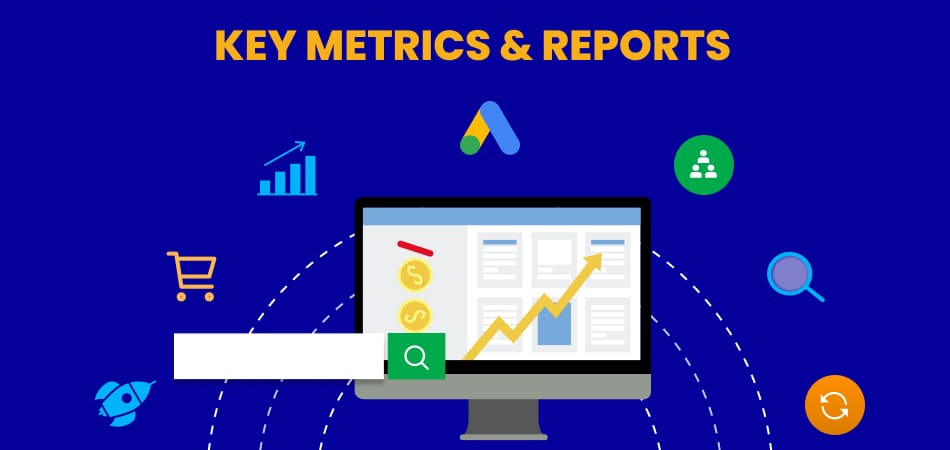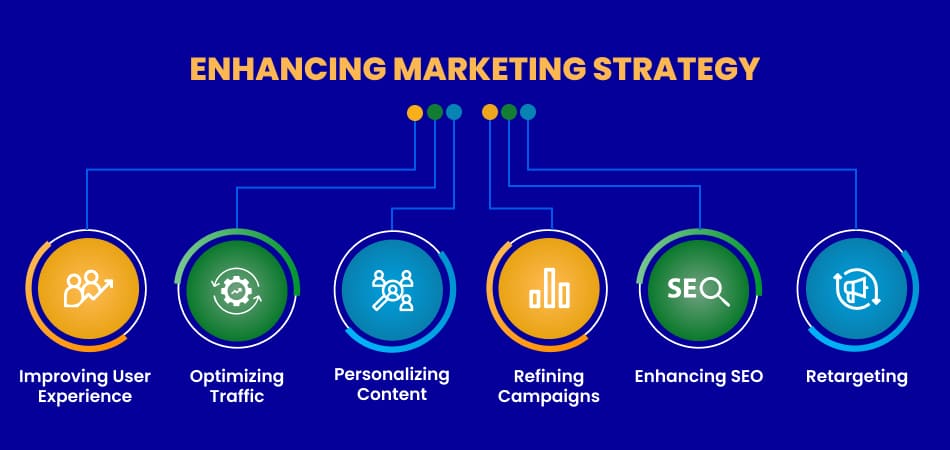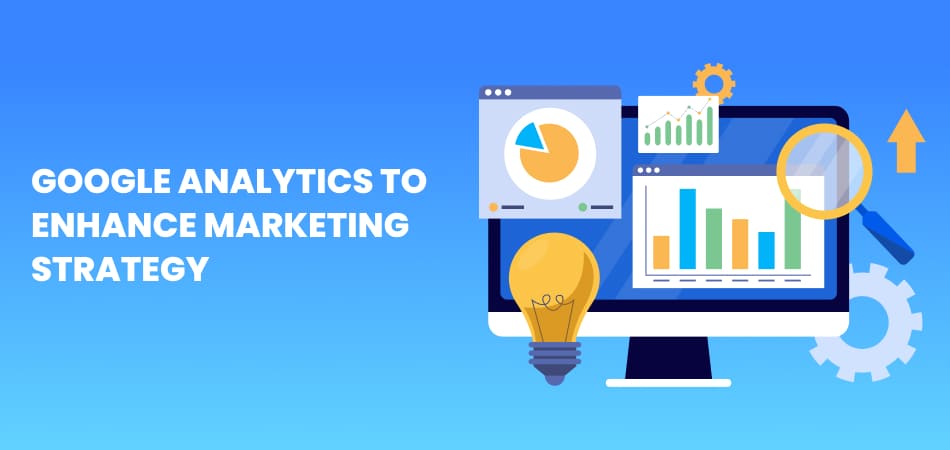Introduction
Making judgments based on data is not only beneficial but also necessary in the ever-changing realm of digital marketing. A robust and free tool from Google, Google Analytics offers in-depth information on user behavior, website traffic, and the effectiveness of your marketing initiatives. Understanding these insights allows you to optimize your marketing efforts, ultimately leading to better ROI and increased user engagement.
This blog will walk you through the key features of Google Analytics, guide you on how to set it up, and explain how you can leverage this tool to enhance your marketing strategy.
Setting Up Google Analytics
Setting up Google Analytics properly is crucial before you can begin data analysis. Here’s how you can do it:
- Create a Google Analytics AccountFirst of all, you need to create an account for getting started Google Analytics. Sign up with your Google account by going to the Google Analytics website. If you don’t have one yet, you’ll need to create one first.
- Set Up a PropertyIn Google Analytics your website or app is depicted as a property. You can have multiple properties in one account, each representing a different platform (e.g., website, mobile app). To set up a property, you will need to enter basic details like the website’s URL and its industry category.
- Install the Tracking CodeAfter setting up the property, you’ll be provided with a tracking code. This code needs to be embedded in the <head> section of every page of your website. You can manually insert the code or use a tag manager, such as Google Tag Manager, to streamline the process.
Google Analytics will start gathering information about your site visitors as soon as the tracking code is placed, giving you the opportunity to begin examining user activity.

Understanding Key Metrics and Reports
Google Analytics provides a wide range of metrics and reports that can help you understand your website’s performance. These are just some of the key metrics and reports you should focus on:
Audience Overview
You may get a quick overview of your website’s visitors with the Audience Overview report. You can learn about your audience’s demographics, interests, geographical location, and the devices they use. Understanding this data enables you to customize your marketing strategy to more effectively engage with your audience.
| Metric | Description |
| Demographics | Age, gender, and interests of your visitors |
| Geography | The location of your audience, helping you localize campaigns |
| Behavior | Frequency of visits, returning users, and page engagement |
Acquisition Reports
How people find your website is displayed in the Acquisition report. The major traffic sources include:
| Traffic Source | Description |
| Organic Search | Traffic from search engines like Google |
| Direct | People who enter your URL in their browser |
| Referral | Visitors arriving via links from other websites |
| Social | Traffic that comes from social networking sites like Twitter, Facebook, and others. |
| Paid Search | Traffic from paid ads like Google Ads |
By identifying your most effective traffic sources, you can adjust your marketing strategy to focus on the channels that generate the best results.
Behavior Reports
Insights on how users interact with your website is provided by The Behavior report. Some of the key reports under this category include:
| Report Type | Description |
| Site Content | Depicts the pages on your website that are most viewed. |
| Site Speed | Measures the load time of your pages, which affects user experience and SEO |
| Site Search | Depicts what users are searching for on your website |
Conversion Reports
For assessing how successfully your website is accomplishing business goals, the conversion report is essential. Google Analytics lets you set up and track Goals, such as form submissions, newsletter sign-ups, or product purchases.
| Conversion Type | Description |
| Goals | Keep track of particular activities, such as completing forms or subscribing to newsletters. |
| E-commerce | Track sales, revenue, and transaction data for e-commerce websites |
| Multi-Channel Funnels | Tracks how different channels work together to convert users |
Utilizing Advanced Features
To truly maximize the power of Google Analytics, it’s important to use some of its advanced features. The below are some amazing features:
Custom Dashboards
One of the most useful advanced features is the ability to create Custom Dashboards. These dashboards enable you to track essential metrics pertinent to your business. For instance, you can create a dashboard that focuses on user behavior, such as page views, bounce rates, and goal completions. Custom dashboards streamline productivity by consolidating key data into a single, easily accessible location.
Segmentation
Segmentation enables you to break down your data into smaller, more meaningful groups. You can divide up your audience, for instance, by:
| Segment Type | Description |
| Demographics | Age, gender, location, etc. |
| Behavior | New vs. returning users, or those who have engaged with specific content |
| Traffic Source | Organic, paid, or social traffic |
This segmentation helps you gain more granular insights into different user groups, allowing for more targeted marketing.
Event Tracking
Event Tracking is an excellent feature for tracking specific user interactions on your website. For example, you can monitor:
| Event Type | Description |
| Button Clicks | Tracking button interactions on the website |
| Video Plays | Monitoring when users play videos embedded on your site |
| Form Submissions | Keeping track of completed form submissions |
| File Downloads | Monitoring when users download files from your site |
These insights allow you to better understand user behavior and optimize your website accordingly.
Goals and Funnels
Setting up Goals and visualizing Funnels is essential for tracking conversions. A Goal represents a desired action on your site, such as a purchase or form submission. Funnels visualize the steps users take before completing a goal, such as adding an item to their cart and proceeding to checkout.
| Funnel Step | Description |
| Step 1 | Visitors add items to their cart |
| Step 2 | Visitors proceed to checkout |
| Step 3 | Visitors complete the purchase |
By analyzing your funnels, you can identify where users drop off and optimize those areas to improve conversion rates.

Enhancing Your Marketing Strategy
Now that you’re familiar with the key features and reports in Google Analytics, let’s dive into how you can use the data to enhance your marketing strategy.
- Improving User ExperienceThe Behavior Flow report is an excellent tool for understanding how users navigate your website. By identifying pages where users drop off or spend less time, you can pinpoint areas that need improvement. For example, if users are leaving after visiting a particular page, consider revising the content or design to make it more engaging.
- Optimizing Traffic SourcesBy examining yourAcquisition reports, you can determine which channels are driving the most valuable traffic. For example, if you notice that your paid ads are performing better than social media campaigns, consider reallocating your budget to focus more on paid advertising.
- Personalizing ContentThe Audience reports offer valuable insights into the interests and demographics of your visitors. Make use of this information to better customize your content to your audience’s tastes. For example, if you’re attracting a large number of tech-savvy users, consider creating more advanced, technical content.
- Refining CampaignsThe Campaigns report in Google Analytics lets you monitor the effectiveness of your marketing initiatives. Setting up UTM Parameters allows you to monitor the effectiveness of specific links and campaigns. If a particular campaign isn’t performing well, you can adjust your strategy in real time.
- Enhancing SEOGoogle Analytics can be integrated with Google Search Console, enabling you to track the search queries that drive organic traffic to your website. By analyzing these keywords, you can optimize your content and enhance your search rankings.
- RetargetingGoogle Analytics enables Remarketing by creating lists of users who visited your site but didn’t convert. You can then target these users with personalized ads, encouraging them to return and complete their purchase or conversion goal.
Data-Driven Decision Making
One of the greatest benefits of using Google Analytics is that it enables you to make decisions based on data. Here are two key strategies to take advantage of:
A/B Testing
By using data from Google Analytics, you can identify which elements of your website or marketing campaigns are working best. You can run A/B tests to compare two versions of a webpage, ad, or call-to-action (CTA). Google Analytics will help you measure the performance of each version, allowing you to choose the most effective one.
Predictive Analysis
Google Analytics also offers predictive insights based on historical data. These insights can help predict latest trends and guide your future marketing decisions. For example, if you notice a pattern of increased sales in the months leading up to the holidays, you can adjust your marketing strategy to capitalize on that trend.
Conclusion
Google Analytics is more than just a tracking tool – it’s a critical asset for improving your marketing strategy. By understanding and using its features, you can gain deeper insights into your audience, refine your marketing campaigns, and ultimately achieve better results. Whether you’re optimizing user experience, adjusting traffic sources, or improving content, the data from Google Analytics can guide your decisions and help you grow your business.



